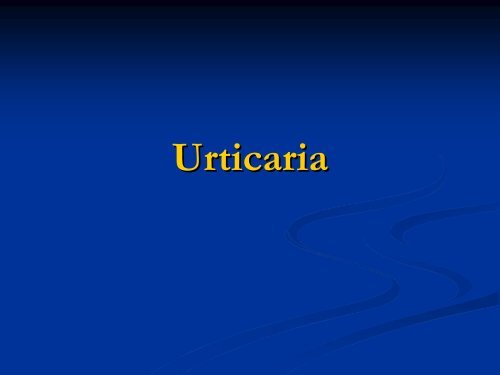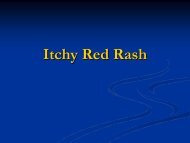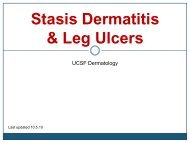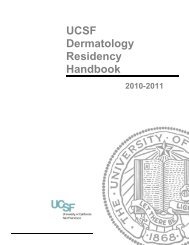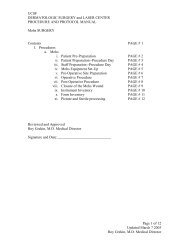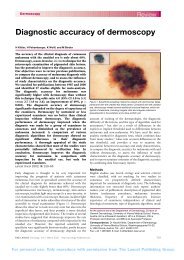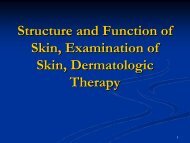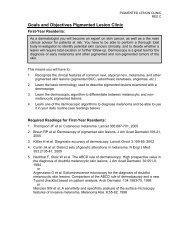Urticaria - Dermatology
Urticaria - Dermatology
Urticaria - Dermatology
You also want an ePaper? Increase the reach of your titles
YUMPU automatically turns print PDFs into web optimized ePapers that Google loves.
<strong>Urticaria</strong>
Module Instructions<br />
The following module contains hyperlinked<br />
information which serves to offer more<br />
information on topics you may or may not be<br />
familiar with. We encourage that you read all the<br />
hyperlinked information.
<strong>Urticaria</strong>: Basic Facts<br />
<strong>Urticaria</strong><br />
is a vascular reaction of the skin and appears as<br />
wheals surrounded by a red halo or flare.<br />
Cardinal symptom is PRURITUS<br />
As high as 15-25% 15 25% of the population experience urticaria, urticaria,<br />
of these 40% have urticaria, urticaria,<br />
10% have angioedema, angioedema,<br />
50%<br />
have both<br />
Angioedema<br />
is caused by swelling of subcutaneous tissue<br />
whereas urticaria<br />
is caused by swelling of the dermis<br />
Both angioedema<br />
and urticaria<br />
can result in respiratory<br />
compromise and hypotension<br />
Angioedema<br />
and/or urticaria<br />
may be the cutaneous<br />
presentation of anaphylaxis, so assessment of the<br />
respiratory and cardiovascular systems is vital!
<strong>Urticaria</strong>: Basic Facts<br />
<strong>Urticaria</strong> can evolve over days-weeks days weeks or after a<br />
number of minutes.<br />
Individual wheals rarely last >12hrs<br />
<strong>Urticaria</strong> can be immunologic (IgE ( IgE dependent,<br />
type 1 hypersensitivity or complement<br />
mediated), non-immunologic non immunologic (direct or indirect<br />
mast cell degranulation), degranulation),<br />
or idiopathic (more<br />
than 50% of cases)
Uticaria: Uticaria:<br />
Basic Facts<br />
<strong>Urticaria</strong> can be acute or chronic, chronic urticaria<br />
lasts<br />
>6wks<br />
>50% of chronic urticaria<br />
is idiopathic. 7-17% 7 17% are caused<br />
by physical stimuli such as exercise, sun, temperature<br />
changes, and pressure (the physical urticarias) urticarias<br />
Physical urticarias<br />
are confirmed by challenge test with the<br />
respective trigger. Normally the urticarial<br />
lesions resolve very<br />
quickly after the physical stimuli is removed i.e.
<strong>Urticaria</strong>: Basic Facts<br />
Pathophysiology<br />
(immunologic urticaria): urticaria):<br />
when an<br />
antigen binds to IgE<br />
on the mast cell surface,<br />
degranulation<br />
results in release of histamine<br />
Histamine binds to H1 and H2 receptors to cause<br />
arteriolar dilatation, venous constriction and<br />
increased capillary permeability.<br />
This increases blood flow to the area and<br />
increased fluid travel to interstitial space
<strong>Urticaria</strong>: Basic Facts<br />
Pathophysiology<br />
(non-immunologic<br />
(non immunologic urticaria): urticaria):<br />
it is not<br />
dependent on the binding of IgE<br />
receptors.<br />
For example, aspirin may induce histamine release<br />
through a pharmacologic mechanism where its effect on<br />
arachidonic<br />
acid metabolism causes a release of<br />
histamine from mast cells.<br />
Physical stimuli may induce histamine release through<br />
direct mast cell degranulation<br />
Histamine then acts as described previously
Richard E. Klabunde, PhD<br />
<strong>Urticaria</strong>: Basic Facts<br />
When histamines<br />
are present: Pc<br />
decreases due to<br />
vasodilation, σ<br />
increases and other<br />
variables remain<br />
constant. Thus,<br />
NDF is more<br />
negative and more<br />
fluid leaves the<br />
capillary bed
Case 1
Case 1: History<br />
HPI: 36 year old female with a 3 day history of a<br />
widespread itchy rash. Individual lesions last<br />
approximately 8hrs.<br />
PMH: hip replacement 2 months ago<br />
Allergies: none<br />
Meds: vicodin, vicodin,<br />
aspirin (started following hip<br />
replacement<br />
FH: no history of eczema or allergies<br />
SH: lives at home in the city, began using Tide<br />
detergent<br />
ROS: negative
Case 1: Exam<br />
Gen: VSS<br />
Skin: erythematous papules<br />
coalescing into plaques (wheals-<br />
HL) diffusely on the back
Case 1: Question 1<br />
What other part(s) part(s)<br />
of the exam are essential?<br />
a. Respiratory exam<br />
b. Musculoskeletal exam<br />
c. Neurologic exam<br />
d. Psychiatric exam<br />
e. all of the above
Case 1: Question 1<br />
Answer: a<br />
What other part(s) part(s)<br />
of the exam are essential?<br />
a. Respiratory exam<br />
b. Musculoskeletal exam<br />
c. Neurologic exam<br />
d. Psychiatric exam<br />
e. all of the above
Respiratory Exam<br />
In cases of acute urticaria<br />
it is important to make<br />
sure the patient does not develop airway<br />
compromise.<br />
Pulmonary exam would reveal wheezing or signs<br />
of respiratory distress.
Case 1: Question 2<br />
What is the important feature(s) feature(s)<br />
of the history<br />
revealed in this case?<br />
a. She recently began new medications<br />
b. The lesions last 8hrs<br />
c. She recently began a new detergent<br />
d. all of the above<br />
e. a+b
Case 1: Question 2<br />
Answer: e<br />
What is the important feature(s) feature(s)<br />
of the history<br />
revealed in this case?<br />
a. She recently began new medications<br />
b. The lesions last 8hrs<br />
c. She recently began a new detergent<br />
d. all of the above<br />
e. a+b
Diagnosis: Aspirin Induced <strong>Urticaria</strong><br />
<br />
<br />
Medications are a common cause of urticaria<br />
and<br />
angioedema.<br />
Penicillin and related abx<br />
are common via the<br />
immunologic mechanism<br />
Aspirin is a common cause via the non-immunologic<br />
non immunologic<br />
mechanism<br />
30% of chronic urticaria<br />
is exacerbated by<br />
aspirin/NSAIDs<br />
aspirin/ NSAIDs<br />
Many patients ask about detergent use, however it<br />
causes irritant or allergic contact dermatitis NOT<br />
urticaria
Lesion Duration<br />
Lesions typically last
<strong>Urticaria</strong>l<br />
DDx<br />
vasculitis<br />
of <strong>Urticaria</strong><br />
Bullous pemphigoid<br />
Erythema multiforme<br />
Insect bites<br />
Allergic contact dermatitis (initial phase)<br />
The above diagnoses typically have lesions lasting<br />
>24hrs and thus SHOULD BE BIOPSIED
CASE 2
Case 2: History<br />
HPI: While working in the ER, you see a 25 yr old<br />
woman who was brought in by her husband after being<br />
found unconscious in the backyard, wheezing and<br />
developing a rash.<br />
PMH: asthma<br />
All: aspirin<br />
Meds: none<br />
FH: non-remarkable<br />
non remarkable<br />
SH: recently entered cooking school<br />
ROS: +SOB
Case 2: Exam<br />
VS: T: 98.6F, HR: 110,<br />
BP: 90/50, RR: 34<br />
Gen: women sitting with<br />
some breathing difficulty<br />
and in distress<br />
Respiratory: bilateral<br />
rhonchi<br />
Skin: periorbital edema<br />
and scattered<br />
erythematous papules<br />
and plaques on the<br />
abdomen.
Case 2: Question 1<br />
Which of the following is most often implicated<br />
in anaphylaxis?<br />
a. Hymenoptera bee sting<br />
b. Lobster<br />
c. Peanuts<br />
d. Penicillin
Case 2: Question 1<br />
Answer: d<br />
Which of the following is most often implicated<br />
in anaphylaxis?<br />
a. Hymenoptera sting (2 nd most common cause)<br />
b. Lobster (less common than others, but<br />
relatively common among foods)<br />
c. Peanuts (same as lobster)<br />
d. Penicillin (most common along with<br />
NSAIDs<br />
and radiographic contrast)
Some common causes of anaphylaxis<br />
<br />
<br />
<br />
<br />
Foods including peanuts, other nuts, fish,<br />
shellfish, egg, milk, sesame<br />
Bee stings<br />
Latex<br />
Medications including penicillin, NSAIDs, NSAIDs,<br />
opiates, IV anesthetics, and radiocontrast<br />
dyes
Case 2: Question 2<br />
What is the next course of action in this patient?<br />
a. Make a food diary<br />
b. Administer metoprolol<br />
c. Assess ABC’s ABC s (airway, breathing, circulation)<br />
d. Give topical corticosteroids
Case 2: Question 2<br />
Answer: c<br />
What is the next course of action in this patient?<br />
a. Make a food diary<br />
b. Administer metoprolol<br />
(as in asthma a beta<br />
blocker would be contraindicated)<br />
c. Assess ABC’s ABC s (airway, breathing,<br />
circulation)<br />
d. Give topical corticosteroids
Anaphylaxis<br />
Anaphylaxis can develop quickly into an<br />
emergent situation<br />
Always inquire about oropharyngeal<br />
swellings or<br />
breathing difficulty in patients with hives<br />
If patient gets recurrent swellings without hives<br />
or pruritus, pruritus,<br />
consider medications such as ACE<br />
inhibitors and hereditary angioedema<br />
as a<br />
possible cause
Management of Anaphylaxis<br />
ABC’s ABC s first!<br />
Make sure airway is patent or else intubation<br />
may be emergently necessary<br />
O2 via mask along with 5% metaproterenol<br />
(beta agonist) for angioedema<br />
Administer 0.3-0.5ml 0.3 0.5ml in 1:1000 epinephrine<br />
dilution IM repeating every 10-20min 10 20min as<br />
necessary
Management of Anaphylaxis<br />
Second line therapies:<br />
25-50mg 25 50mg hydroxyzine<br />
6hrs.<br />
or benadryl<br />
IM every<br />
250mg hydrocortisone or 50mg<br />
methylprednisolone<br />
IV every 6hrs for 2-4 2 4 doses<br />
Aminophylline<br />
6mg/kg loading over 30min and<br />
then 0.3-0.9mg/kg/hr 0.3 0.9mg/kg/hr IV<br />
If patient remains unresponsive, norepinephrine<br />
and glucagon can be added
CASE 3
Case 3: History<br />
HPI: 23 yr old man presents with a 48 hour history of<br />
widespread rash. He notes that the same lesions are<br />
present as when his rah began. He does not note any<br />
new ingestions or illnesses recently and is otherwise<br />
feeling well<br />
PMH: none<br />
All: none<br />
Meds: none<br />
FH: non-remarkable<br />
non remarkable<br />
SH: lives alone in the city and attends college<br />
ROS: negative
Case 3: Exam<br />
Gen: well appearing in<br />
NAD<br />
Resp: no wheezes, rales,<br />
rhonchi<br />
Skin: pt has scattered well<br />
circumscribed target<br />
lesions measuring 5-10mm<br />
in diameter<br />
Grouped vesicles are noted<br />
on the lower lip
Case 3: Question 1<br />
What is the most likely diagnosis?<br />
a. urticaria<br />
b. erythema<br />
multiforme<br />
minor<br />
c. poison ivy/oak<br />
d. psoriasis<br />
e. atopic dermatitis
Case 3: Question 1<br />
Answer: b<br />
What is the most likely diagnosis?<br />
a. urticaria<br />
b. erythema<br />
(lesions present >24hrs, so unlikely)<br />
multiforme<br />
minor<br />
c. poison ivy/oak (causes contact dermatitis with<br />
vesicles and it is not targetoid)<br />
d. psoriasis (see psoriasis module)<br />
e. atopic dermatitis (see atopic dermatitis module)
Erythema Multiforme<br />
(EM)<br />
Erythema multiforme<br />
minor<br />
as in this case is<br />
also know as herpes simplex-associated<br />
simplex associated<br />
erythema<br />
multiforme<br />
(HAEM)<br />
Typically, the disease is self-limited self limited and<br />
recurrent during the spring and fall in young<br />
adults<br />
<br />
Seasonal variation is due to the fact that orolabial<br />
herpes is triggered by sunlight exposure. Therefore,<br />
sunlight triggers HSV which triggers EM.
Erythema Multiforme<br />
on Exam<br />
The lesions begin as erythematous<br />
macules<br />
and<br />
progress to papules over 1-2 1 2 days<br />
The central area can become flat or form a<br />
vesicle<br />
Typically the areas of involvement are acral, acral,<br />
and<br />
involvement of palms and soles is characteristic<br />
Mucous membrane involvement, especially of<br />
the oral mucosa can occur (usually involving only<br />
one mucous membrane)
CASE 4
Case 4: History<br />
HPI: 65 yo<br />
M presents with diffuse rash and blistering<br />
and crusting of the lips. He has had a cough last week<br />
and has had a fever for the past 3 days.<br />
PMH: none<br />
All: none<br />
Meds: started on bactrim<br />
for presumed pneumonia last<br />
week<br />
FH: non-remarkable<br />
non remarkable<br />
SH: non-remarkable<br />
non remarkable<br />
ROS: +fever, +fatigue
Case 4: Exam<br />
Gen: toxic appearing,<br />
+lymphadenopathy<br />
Skin: diffuse purpuric<br />
macules coalescing into<br />
patches, some with<br />
central blistering<br />
localized to chest, arms<br />
and palms.<br />
Hemorrhagic crusting of<br />
the lips
Case 4: Question 1<br />
What is the most likely diagnosis?<br />
a. erythema<br />
multiforme<br />
minor<br />
b. Stevens-Johnson Stevens Johnson syndrome<br />
c. disseminated HSV<br />
d. bullous<br />
pemphigoid
Case 4: Question 1<br />
Answer: b<br />
What is the most likely diagnosis?<br />
a. erythema<br />
multiforme<br />
minor (we would have expected<br />
more acral<br />
involvement and less mucous membrane<br />
involvement)<br />
b. Stevens-Johnson Stevens Johnson syndrome<br />
c. disseminated<br />
HSV<br />
(would expect more grouped<br />
vesicles on the body)<br />
d. bullous<br />
pemphigoid<br />
(would not expect such an acute,<br />
severe presentation)
Stevens-Johnson Stevens Johnson Syndrome<br />
Steven Johnson’s Johnson s Syndrome primarily affects at<br />
least 2 MM and involves 30% BSA involvement<br />
10-30% 10 30% BSA involvement is considered<br />
SJS/TEN overlap
Stevens-Johnson Stevens Johnson Syndrome<br />
Typically have an accompanying fever and possibly<br />
prodromal<br />
URI<br />
Distribution is more diffuse and lesions are more<br />
confluent than in erythema<br />
multiforme<br />
minor.<br />
Lesions begin on the face and trunk and often<br />
appear as purpuric<br />
macules<br />
with central blistering<br />
2+ mucous membranes are involved
Stevens-Johnson Stevens Johnson Syndrome<br />
In adults, typically caused by medications<br />
including sulfonamides, antibiotics, NSAIDs, NSAIDs,<br />
allopurinol, allopurinol,<br />
and anticonvulsants<br />
In children, Mycoplasma<br />
pneumoniae<br />
is also a<br />
common cause<br />
Radiation therapy of malignancy may also trigger<br />
SJS
Complications<br />
Most common complication of EM/SJS is<br />
VISUAL LOSS due to corneal scarring from the<br />
MM involvement<br />
TEN is associated with significant mortality (5- (5<br />
15%)<br />
<br />
Factors associated with worse outcome are age, how<br />
long offending medication is continued, HIV status,<br />
and BSA of involvement
Treatment in EM Minor<br />
EM minor is often self-limited self limited in children<br />
and resolves within 2-6 2 6 weeks<br />
In herpes associated cases, antivirals<br />
can be<br />
used as prophylactically<br />
and will prevent<br />
recurrence in 50% of cases
Treatment in SJS<br />
In SJS, secondary infection is a possibility given skin<br />
loss and therefore antibiotics should be given<br />
In cases of >10-30% >10 30% skin involvement, the patient<br />
should be placed in a burn unit and IVIg<br />
is<br />
considered<br />
In severe cases, biopsy is ALWAYS done to<br />
confirm the diagnosis and it is the only<br />
dermatologic condition where a frozen section is<br />
done
END OF MODULE


